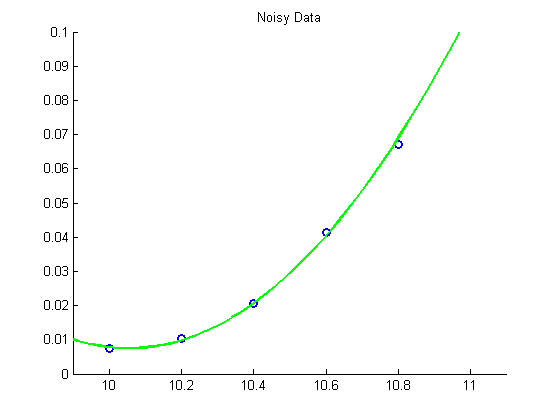LSQquadQR.m
Contents
Overview
Illustrates the use of the QR decomposition for the computation of a polynomial least squares fit
Example 1: Solving the least squares problem using QR decomposition
Data comes from the quadratic polynomial (no noise)

clear all close all x = [10:0.2:11]'; disp('Clean Data') y = [0:0.2:1]'.^2/10; m = length(x); hold on plot(x, y, 'bo', 'LineWidth',2) xlim([9.9 11.1]) ylim([0 0.1]) %pause disp('Solving least squares problem with QR decomposition') A = [x.^2 x ones(m,1)] % Compute the QR decomposition of A [Q R] = qr(A) Rhat = R(1:3,1:3) z = Q(:,1:3)'*y; c = Rhat\z xx = linspace(9.9,11.1,50); yy = c(1)*xx.^2+c(2)*xx+c(3); plot(xx, yy, 'g-', 'LineWidth', 2) title('Clean Data') disp('Fitting with quadratic polynomial') disp(sprintf('p(x) = %3.2fx^2 + %3.2fx + %3.2f',c)) hold off
Clean Data
Solving least squares problem with QR decomposition
A =
100.0000 10.0000 1.0000
104.0400 10.2000 1.0000
108.1600 10.4000 1.0000
112.3600 10.6000 1.0000
116.6400 10.8000 1.0000
121.0000 11.0000 1.0000
Q =
0.3691 0.6074 0.5623 -0.1881 -0.0850 -0.3687
0.3840 0.3872 -0.0987 0.5732 0.3351 0.5020
0.3992 0.1579 -0.4326 -0.6543 -0.2266 0.3861
0.4147 -0.0806 -0.4392 0.4051 -0.4804 -0.4834
0.4305 -0.3282 -0.1187 -0.1994 0.7254 -0.3561
0.4466 -0.5848 0.5291 0.0635 -0.2685 0.3201
R =
270.9125 25.7197 2.4443
0 0.8335 0.1589
0 0 0.0022
0 0 0
0 0 0
0 0 0
Rhat =
270.9125 25.7197 2.4443
0 0.8335 0.1589
0 0 0.0022
c =
0.1000
-2.0000
10.0000
Fitting with quadratic polynomial
p(x) = 0.10x^2 + -2.00x + 10.00

Example 2: Fit "noisy" data using a quadratic polynomial
Note that we do not need to re-compute the QR decomposition of the matrix  for this part since the matrix
for this part since the matrix  is still the same. Only the data vector
is still the same. Only the data vector  has changed!
has changed!
%pause disp('Noisy Data') % Add 10% noise to the data y = y + 0.1*max(y)*rand(size(y)); figure hold on plot(x, y, 'bo', 'LineWidth',2) xlim([9.9 11.1]) ylim([0 0.1]) %pause disp('Solving noisy least squares problem with QR decomposition') % No need to re-compute the QR decomposition of A since A is the same, only % y has changed! z = Q(:,1:3)'*y; c = Rhat\z xx = linspace(9.9,11.1,50); yy = c(1)*xx.^2+c(2)*xx+c(3); plot(xx, yy, 'g-', 'LineWidth', 2) title('Noisy Data') disp('Fitting with quadratic polynomial') disp(sprintf('p(x) = %3.2fx^2 + %3.2fx + %3.2f',c)) hold off
Noisy Data
Solving noisy least squares problem with QR decomposition
c =
0.1109
-2.2306
11.2219
Fitting with quadratic polynomial
p(x) = 0.11x^2 + -2.23x + 11.22
